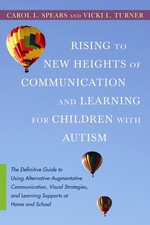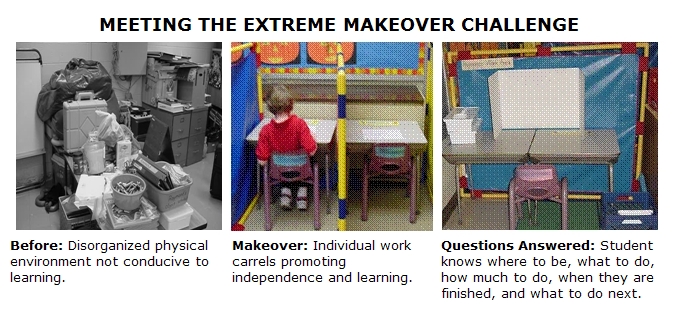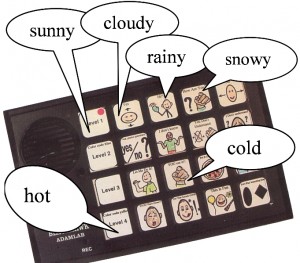The Extreme Makeover Challenge: Room Re-Design!
 by Carol L. Spears and Dr. Vicki L. Turner
by Carol L. Spears and Dr. Vicki L. Turner
As discussed in our book Rising to New Heights of Communication and Learning for Children with Autism, we have observed that disruptive behaviors displayed by children with autism or other PDDs may occur when they don’t know the answers to the following questions:
Where do I need to be?
What do I need to do?
How much do I need to do?
What comes next?
In our work, we have found that physically re-structuring the living and/or learning environment is a strategy which effectively increases the likelihood that appropriate behaviors will increase and inappropriate behaviors will dissipate – assuming the setting is designed effectively.
Whether at school or at home, a well-designed space has designated areas with defined borders for particular tasks. Materials are easily accessible, and the location where they are to be used is clearly identified. All individuals have their own workstations, desks, cubbies/lockers, or places informing where they are to be and what they are to do. By engineering the physical environment, parents, teachers, Speech-Language Pathologists, and others may assist children with exceptional needs by enhancing their learning and functional experiences.
When re-designing spaces for children with autism or other PDDs, visual supports are key because they provide information and tools allowing individuals to:
- comprehend the instructions and communication of others.
- understand and follow directions.
- follow schedules, learn routines, negotiate transitions, accept changes.
- support and improve a child’s receptive language, ultimately improving expressive language, learning, behavior problems, and social skills.
- enhance involvement, participation, and socialization of individuals with autism, the tools may be equally successful for those with other diagnoses.
- complete work independently and work or play appropriately during groups activities.
Whatever visual supports you use – objects, symbols, schedules, choice boards, social stories, or task organizers – being able to see the support will increase comprehension, particularly when auditory difficulties exist.

As consultants, we meet these extreme makeover challenges every day by assisting caregivers and professionals to physically re-structure living and learning environments, and by implementing and linking tailored visual strategies to support expressive communication with Alternative-Augmentative Communication (AAC).
We define AAC as the use of materials, techniques and equipment to compensate for expressive communication limitations individuals may exhibit, and to provide varied methods that allow for success in the communication process. AAC methods are tailored for individuals based on cognitive level, physical abilities, academic needs and communication settings, and include the following most common methods:
 Speech Generating Devices (SGD)
Speech Generating Devices (SGD)
SGDs are electronic equipment with speech output capabilities, that may be programmed, and offer the individual with increased communication opportunities. In Rising, we discuss various uses of SGDs such as in this device which allows children to communicate information between school and home.
Other applications include communicating messages to answer questions, participate in academic lessons, offer social greetings, relay information, exchange thoughts, and interact with significant members in their lives at home, school, and in the community.
Picture Exchange Communication System ( PECS)
PECS is an augmentative communication system designed to facilitate quick, effective, functional communication. It is a concrete visual-based program that encourages communication. Although speech emerges with some individuals and verbal speech is indirectly encouraged, PECS is not specifically designed to teach speech. Its primary objective is to establish an understanding about the purpose and method of communication exchanges, and to facilitate communication by providing the opportunity to relay messages through pictures. We have found a number of our students have been very successful communicating via PECS.
Symbolic Language System
We define symbolic language systems as any method of communication that utilizes an action or material, assigns specific messages to it, and relies upon it consistently to relay meaning to the listener. A symbolic language system provides a consistent and easy-to-interpret method of relaying messages when a verbal message cannot be presented intelligibly. Pictures of items or places, labels of products, objects, gestures, and vocalizations are most commonly used to depict representations of desired messages. Rising illustrates many types of symbolic language systems to relay messages for many communication situations such as communication boards, eye gaze charts, and communication binders.
These are some of the elements required to meet the challenge of a successful re-design. We have observed children with autism, other PDDs, and AAC , achieve organization and success, improved behavior, social skills, and communication success when adults implement the strategies we’ve shared.
Carol L. Spears and Dr. Vicki L. Turner are Speech Language Pathologists, Assistive Technologists, and Alternative/Augmentative Communication Specialists. They utilize extensive professional experience, continuing education, and personal perspectives when working with students with autism and other pervasive developmental disorders to provide evidence based interventions. They are partners in the private consultation practice, Communication by Design Specialists, LLC (CoDeS). CoDeS, located in Northeast Ohio, USA, provide caregivers and professionals with compassionate support and training in homes, educational institutions, and workshop settings.
Copyright © Jessica Kingsley Publishers 2010.